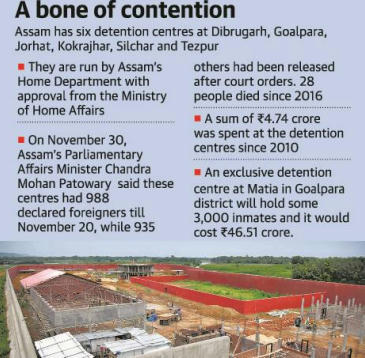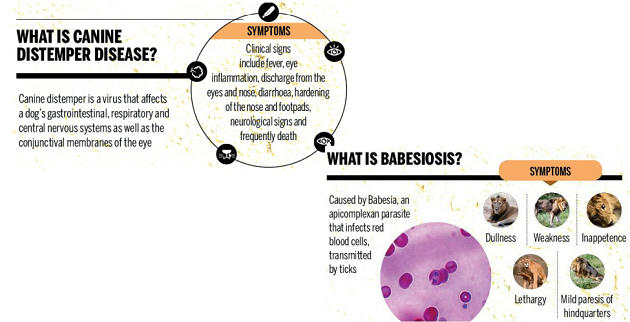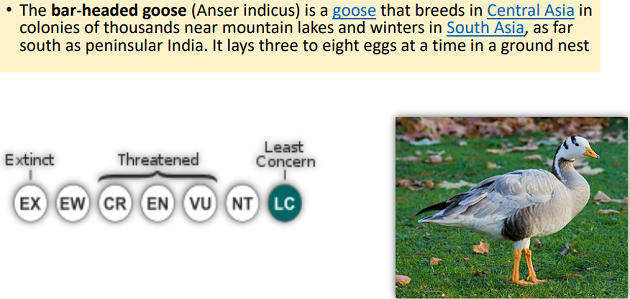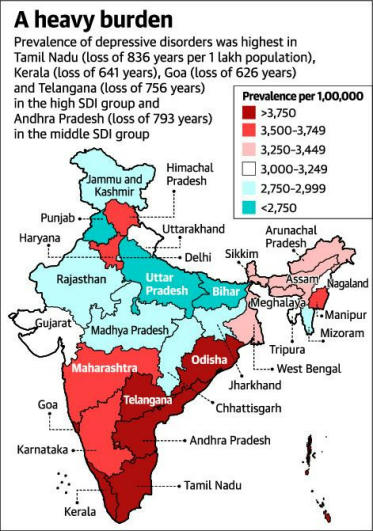Table of Contents
- Persons released from detention centres recount ‘horror’
- Guwahati-based retired Army officer Mohammed Sanaullah smiled wryly as he watched Prime Minister Narendra Modi’s televised speech at Ramlila Maidan in New Delhi on Sunday.
- His “ears laughed” when Mr. Modi said: “No Indian Muslims are being sent to detention centres and neither are there any detention centres in this country.”
- On June 8, the Gauhati High Court released Sanaullah on bail from the Goalpara central jail, one of six in Assam that also serve as detention centres for people declared non-citizens by 100 functional Foreigners’ Tribunals (FTs).
- He was lodged in the Goalpara centre on May 28. “So what is that place where I spent 11 horrific days called? If I had not been sent to a detention centre by the State machinery, maybe I am not a Muslim too,” he told The Hindu. A ‘sad’ reality that has long been in existence in Assam.

‘It is actually hell’
- About 40 km west in Khopanikuchi, sexagenarian Rehat Ali was equally amused.
- “The PM is right. It is actually hell, not a detention centre,” he said.
- Ali was released on May 13 after the High Court declared him an Indian.
- The family of Dulal Paul, who died of health complications on October 13 after spending two years at the Tezpur detention centre, said the denial of such centres ridiculed his death.
- “If there are no detention centres, my father was not sent to one after being declared a foreigner. In that case, the government should bring him back to life,” one of his three sons said.
- The family had refused to accept Paul’s body for a week, putting the Sarbananda Sonowal government in a spot. Their contention was that since he was marked a foreigner, the government should send his body to whichever country it thought he had come from.
- On November 30, Assam’s Parliamentary Affairs Minister Chandra Mohan Patowary provided data on the number of detention centres and how many declared foreigners they housed. This was two days after Union Minister of State for Home Affairs Nityanand Rai said in Parliament that there were 1,043 foreigners — 1,025 Bangladeshis and 18 Myanmarese — across Assam’s six detention centres.
- The detention centres are run by Assam’s Home Department with approval from the Home Ministry.
- Released declared foreigners said four-five rooms within the central jails serve as detention centres.
- “Each room is crammed with 50-60 people. Even the worst of enemies should not be sent there,” Ali said.
Man mauled to death by lion in Gir forest area
- Gir forest is the only abode of Asiatic lions.
- As per the last census in 2015, there were around 523 lions in the State, mainly in the forest areas of Junagadh, GirSomnath, Amreli and Bhavnagar districts.
- Asiatic lions are cousins of the African lion.
- They are believed to have split away 100,000 years ago.
- They are slightly smaller and have distinctive fold of skin along their bellies.
- Gir sanctuary is the only wild population of Asiatic lions in the world.
- With serious conservation efforts of the State and the Union Government, the population of Asiatic lions have increased to over 500 which used to be around 50 by late 1890s.
- According to the last census conducted in 2015, the number of lions in Gir sanctuary stood at 523.
- It is listed in Schedule I of Wildlife (Protection) Act 1972, has been categories as Endangered on IUCN Red List and is listed Appendix I of CITES.
- The Gir Protected Area Network of Gujarat includes Gir National Park, Gir Sanctuary, Pania Sanctuary, Mitiyala Sanctuary and adjoining forests. It has an area of 1648.79 sq. km.
Canine distemper virus (CDV)
- CDV is highly contagious disease that attacks gastrointestinal, respiratory, central nervous systems, immune system and other vital organs in animals.
- In most of the cases, the infection is fatal.
- It is mainly found in wild dogs, jackals and wolves.
- The disease can be contracted by lions if they eat any animal infected by it.
- CDV is considered dangerous virus and is blamed for wiping out 30% population of African lions in East African forests.
- The virus is blamed for the death of as many as 23 lions in Gujarat’s Gir sanctuary in less than month.

Asiatic Lion Conservation Project
- The “Asiatic Lion Conservation Project” has been launched by the Ministry of Environment, Forest and Climate Change(MoEFCC).
- The main objective of this project is to work for the conservation of the world’s last ranging free Asiatic Lion population and the ecosystem associated with it.
- The project will be funded under the ‘Development of Wildlife Habitat (CSS-DWH)’ scheme which is a Centrally Sponsored Scheme.
- The cost will be borne in the 60:40 ratio by the Central and State government.
- The main activities under the ‘Asiatic Lion Conservation Project’ include
- habitat improvement of the Lions,
- controlling of diseases among the population,
- scientific interventions and
- adequate veterinary care.
- It will be supplemented with sufficient eco-development works ensuring a stable and viable Lion population in India.
Andhra Pradesh committed to Kadapa steel plant: Jagan
- Laying the foundation for the three million tonne per annum Kadapa Steel Plant (KSP) at Sunnapurallapalle village in Jammalamadugu mandal of Kadapa district on Monday, Andhra Pradesh Chief Minister Y.S. Jagan Mohan Reddy promised to shoulder the responsibility of completing it even if big private companies did not come forward to invest in the project estimated to cost ₹15,000 crore.
- The steel plant, which was incorporated as A.P. High Grade Steels Limited, is one of the major promises made at the time of bifurcation of the unified State of Andhra Pradesh.
- Pointing out that the five-year wait for the steel plant did not bear any fruit, Mr. Reddy asserted that the present government would fulfil that dream in three years.
- Addressing a public meeting, Mr. Reddy said the most important step of sourcing iron ore had already been taken in the form of the MoU signed with the National Mineral Development Corporation (NMDC) a few days ago.
- Moreover, the steel plant would provide direct and indirect employment to nearly 25,000 people.
- The State allotted about 3,275 acres in Sunnapurallapalle and Peddanandaluru villages for the plant
- Bar-headed goose spotted in Pandalam -Karingali Puncha in Pathanamthitta district is a major birding spot
- A six-member team attached to Pathanamthitta Birders has spotted the Bar-headed goose (Anser Indicus) in the wetlands of Karingali Puncha, near Pandalam, reportedly the first sighting in the district.
- The Puncha is a major birding spot in the district which reported the highest bird count in the Asian Waterfowl Census of 2015.
- bar-headed goose was the 336th bird species found in the district. Bar-headed geese are found in central China and Mangolia and they breed there.
- They start migration to the Indian sub-continent during the winter and stay here till the end of the season.
- They are one of the birds which can fly even at very high altitude. They come to India and return to their homes by crossing the Himalayan ranges.
- Their migration has been a fascination for birders as
- they cross the Himalayas on one of the most high-altitude migrations in the world.
- Their ability to sustain the high oxygen demands of flight in air that is exceedingly oxygen-thin is exceptional.
- The capacity of bar-headed geese to transport and consume oxygen at high rates in hypoxia distinguishes this species from similar lowland waterfowl.
- Two years ago, a few birds were observed in the Periyar Lake at Thekkady. Before that some other observations were made in the Thrissur kole fields and in Kollam. Large flocks used to visit the Koonthakulam bird sanctuary at Tirunelveli, Tamil Nadu. However, it is rare that the bird is spotted in Kerala and the recent sighting at puncha is important, says Mr. Hari.
- The bar-headed goose (Anser indicus) is a goose that breeds in Central Asia in colonies of thousands near mountain lakes and winters in South Asia, as far south as peninsular India. It lays three to eight eggs at a time in a ground nest

South has higher prevalence of mental disorders: study
- Tamil Nadu, Kerala, Telangana, Karnataka and Andhra Pradesh account for a higher prevalence of mental disorders that manifest primarily during adulthood in depression and anxiety, according to the first comprehensive estimates of disease burden attributable to mental health from 1990 prepared by the India State-Level Disease Burden Initiative and published in the Lancet Psychiatry.
- The study finds that roughly one in seven Indians, or 197 million persons, suffered from mental disorders of varying severity in 2017.
- These include depression, anxiety disorders, schizophrenia, bipolar disorders, idiopathic developmental intellectual disability, conduct disorders, and autism.
- Importantly, the contribution of mental disorders to the disability adjusted life year (DALY) — the sum of total years of life lost and years lived with disability — has doubled between 1990 and 2017 increasing from 2.5% to 4.7%. Mental disorders were the second leading cause of disease burden in terms of years lived with disability (YLDs) and the sixth leading cause of disability-adjusted life-years (DALYs) in the world in 2017
- In total, 45.7 million people had depressive disorders, as one in three years lost due to a mental disorder was due to depression.
- This was followed by anxiety — a total of 44.9 million people suffered from it and it accounted for the loss of 1 in 5 years.

Three categories
- In its State-wise analysis, the study divides different States into three categories on the basis of their Socio-emographic index (SDI),
- i.e low, medium and high SDI States. The SDI is a composite measure of percapita income, mean education, and fertility rate in women younger than 25 years and is calculated on a scale of one.
- Prevalence of depressive disorders was highest in Tamil Nadu (loss of 836 years per 1 lakh population ), Kerala (loss of 641 years), Goa (loss of 626 years) and Telangana (loss of 756 years) in the high SDI State group and Andhra Pradesh (loss of 793 years) in the middle SDI State group.
- Similarly, anxiety disorders were found to be more common in Kerala (loss of 383 years per 1 lakh population), Himachal Pradesh (loss of 329 years), Tamil Nadu (loss of 325 years), Karnataka (loss of 324 years), Telangana (loss of 324 years), and Maharashtra (loss of 324 years) in the high SDI State group and Andhra Pradesh (loss of 328 years), Manipur (loss of 360 years), and West Bengal (loss of 331 years) in the middle SDI State group.
Three categories
- In its State-wise analysis, the study divides different States into three categories on the basis of their Socio-Demographic index (SDI),
- i.e low, medium and high SDI States. The SDI is a composite measure of percapita income, mean education, and fertility rate in women younger than 25 years and is calculated on a scale of one.
- Prevalence of depressive disorders was highest in Tamil Nadu (loss of 836 years per 1 lakh population ), Kerala (loss of 641 years), Goa (loss of 626 years) and Telangana (loss of 756 years) in the high SDI State group and Andhra Pradesh (loss of 793 years) in the middle SDI State group.
- Similarly, anxiety disorders were found to be more common in Kerala (loss of 383 years per 1 lakh population), Himachal Pradesh (loss of 329 years), Tamil Nadu (loss of 325 years), Karnataka (loss of 324 years), Telangana (loss of 324 years), and Maharashtra (loss of 324 years) in the high SDI State group and Andhra Pradesh (loss of 328 years), Manipur (loss of 360 years), and West Bengal (loss of 331 years) in the middle SDI State group.
‘Road fatalities high among young men’
- Road injury was the leading cause of death in India among 15 to 39-year-old men in 2017 and was the second leading cause for both sexes combined,
- according to the findings of the India State-Level Disease Burden Initiative published in the Lancet Public Health.
- The study gives the first comprehensive population-level estimates of road injury deaths by type of road users in each State.
- Of the 2,19,000 road injury deaths in India in 2017, 77% were of men, with the death rate three times higher as compared to women. The death rate standardized for age was 17.2 deaths per 1 lakh population, but it was 25.7 deaths per 1 lakh male population and 8.5 deaths per 1 lakh women.
- In 2017, pedestrians in India accounted for 35.1% (76,729) of all deaths due to road injuries and older adults were the largest casualties. Motorcyclists accounted for 30.9% (67,524) of all road fatalities, motor vehicle occupants accounted for 26.4% (57,802) and cyclists 7% (15,324) of road fatalities.
- Motorcyclist and cyclist road injury death rates were 69% and 33% higher in India as compared to the global average.
- The study noted that if the estimated trends of road injury deaths up to 2017 were to continue, none of the States are likely to meet the SDG 2020 target of reducing such deaths by half from 2015 to 2020 or even by 2030.
Aadhaar to be made mandatory for GST
- With 66.79 lakh new dealers registered under the Goods and Service Tax contributing just 15% of the total revenue under the tax regime, the GST Network has decided to make Aadhaar authentication or physical verification mandatory for new dealers from January 1, 2020, to check malpractices.
- Briefing about the decisions taken at the GST meeting here, Bihar Deputy Chief Minister Sushil Kumar Modi, who heads the Group of Ministers on Integrated Goods and Services Tax, told the media here that 66.79 lakh new registered dealers were paying just 15% of the taxes, constituting about ₹10,000 crore in monthly collections.
- Monthly collections had crossed the ₹1 lakh-crore- mark in six out of eight months during April-November, 2019, he said.
- The number of registrations under GST stood at 1.21 crore and of this, 55.04 lakh dealers had migrated from the pre-GST regime and 66.79 lakh were new registrations since the launch of GST. He said dealers who migrated to the GST contributed 85% of the total revenue.
- “Aadhaar authentication will be made mandatory for new dealers for registration. We have noticed in two years that a large number of operators are registering themselves as GST dealers. They make fake invoices also.” He said those who declined to give their Aadhaar numbers would have to undergo physical verification.
- A total 24.86 lakh fake or bogus registered dealers had been weeded out from the GST.
- Mr. Modi ruled out any hike in GST rates in the near future. He said the Centre and States were not ready to raise tax rates as the economy was in a slowdown, affecting revenue mobilisation.
- For ensuring smooth compliance by taxpayers and transparency, he said it was decided to launch the new GST returns filing system from April 1, 2020. Noting that “it will be a game-changer, ” Mr. Modi said the new system envisaged the concept of regular invoice upload and proposed to be fully automated involving the reconciliation of invoices before proceeding with input tax credit claims.
- On the occasion of Constitution Day, at a joint sitting of Parliament to mark the 70th anniversary of the adoption of the Constitution, President Ram Nath Kovind, (quoting B.R.Ambedkar) made a significant observation that all three organs of the state, persons occupying constitutional posts, civil society members, and citizens should abide by ‘constitutional morality’.
- The reiteration by the President of an essential truth came not a moment too soon. Concerns are increasingly being voiced by different segments of people regarding violations of the Constitution by those in authority.
- Concerns about the future of democracy and democratic traditions are, no doubt, growing across the world. In quite a few democracies, moreover, one can also perceive a decrease in democratic freedoms and a trend in favour of illiberal populism.
- India was hitherto perceived to be an exception to this, being protected by safeguards found in its Constitution — the product of a Constituent Assembly that consisted of not only the best legal minds, but also of compassionate individuals who espoused the finest human values.
Article 370, and after
- Recent developments in India, however, seem to ‘singe’, without as yet undermining, the basic structure and principles of the Constitution. Steps need to be taken expeditiously to prevent any further slide. For instance, much has been made of the fact of diluting Article 370, that it was a temporary provision. The reality is that it was, nevertheless, a provision made in the Constitution for a specific purpose, which clearly required more detailed and careful treatment before being peremptorily invalidated. Even if the end justified the means, the haste was unwarranted.
- Again, while the Indian Constitution provides for a federal system with a unitary bias, the Central and State Governments both derive their authority from the Constitution. This implies that States are not exactly subordinate to the Centre. Splitting Jammu and Kashmir (J&K) into two Union Territories, without due consultation with different segments and shades of opinion there, including its political leadership, ran contrary to this essential principle. It violated the spirit, if not the letter, of the Constitution.
- Furthermore, while secularism is becoming an ugly word today in many parts of the globe, we in India were free of any such bias. Lately, it would seem, that some of these biases are beginning to emerge in many circles in India as well, undermining our long held secular precepts. In its seminal judgment in the Kesavananda Bharati v. State of Kerala case (1973), the Supreme Court held that secularism is part of the basic structure of the Constitution and cannot be trifled with in the name of security or other considerations.
- These are all portents of danger, and call for a great deal of introspection. They merit a calibrated response. Unfortunately, this does not seem to be happening. Those in authority would do well to heed the warning given by former President Pranab Mukherjee while delivering the second Atal Bihari Vajpayee Memorial Lecture that “A numerical majority in elections gives you the right to make a stable government. The lack of popular majority forbids you from a majoritarian government. That is the message and essence of our parliamentary democracy”.
Drama in Maharashtra
- Constitutional capers are aggravating this situation. The unfortunate drama enacted after the Maharashtra State Assembly results were announced could have been avoided if constitutional proprieties were adhered to. A pre-election alliance of the BJP-Shiv Sena had secured a majority, but the inability of the two allies to resolve issues relating to sharing of power led to a breakdown. President’s rule had to be invoked. Later, after a compromise was reached between the Shiv Sena, the Nationalist Congress Party (NCP) and the Congress to form a government, the President’s rule was revoked in a midnight charade using the Prime Minister’s ‘special powers’, and a BJP-led government was sworn in. The State also witnessed unseemly incidents such as sequestering of MLAs who were taken to safe havens to avoid poaching in the event of a trial of strength in the Assembly. That the attempt to impose a BJP-led government did not succeed is less important than the fact that provisions of the Constitution and the position of constitutional functionaries had been compromised.
- A still more expedient experiment, which conflicts with some of the basic precepts contained in the Constitution, has been the passage of the Citizenship (Amendment) Act (CAA). On the face of it, the CAA only makes it easier for refugees from countries such as Afghanistan, Bangladesh and Pakistan to gain Indian citizenship. The fine point, however, is that it excludes certain categories, such as Muslims. This denies people belonging to one particular religion recourse to the new law.
- While the CAA implicitly violates India’s liberal traditions, when combined with the move to compile a National Register of Citizens, it carries an ominous ring. Many experts had apparently warned that the proposals were in violation of the Constitution, but these warnings were not heeded. That the Citizenship (Amendment) Bill passed through both the Houses without any detailed debate or discussion thereafter is, hence, unfortunate, giving an impression that a majority in Parliament is adequate to push through Acts which may or may not be in tune with the Constitution.
A study was needed
- Whatever be the merits or demerits of the CAA, given India’s many-layered democracy and the existence of different religious communities spread across different regions of the country, a more detailed and in-depth study was called for before pushing through such a key measure. Granting citizenship may be the sole discretion of the Centre, with the States having no role. Yet, this could still be unconstitutional if it violates Articles 8 and 14 of the Constitution.
- The violence in varying degrees of intensity that has erupted across the nation is a testimony to the divisive nature of this latest piece of legislation. The issue of refugees from neighbouring countries has been pending for long. No satisfactory outcomes were readily forthcoming. Given that the Constitution has been the guarantor of equal treatment to people of all religions and regions, and irrespective of geography and history, the issue of refugees called for not only greater understanding, but also more time, so that the fundamental principles of the Constitution were not violated. While piloting the Bill, the Home Minister had mentioned that “if the Congress had not divided this country on the basis of religion, there would have been no need to bring in this Bill”. This is hardly a valid argument. On the other hand, it raises more questions as to what were the real reasons behind the enactment of the Act.
- What is also not understood is the haste with which the Bill was pushed through Parliament. India has been grappling with several more critical issues in recent months, including the state of its economy. To raise this matter at this time seemed uncalled for. At this juncture, it may be worthwhile to quote Winston Churchill ‘the price of greatness is responsibility’. Is India acting responsibly?
MCQ
Federal features in our constitution are related to
- 7th schedule
- Residual powers with parliament
- Post of Governor
- Bicameralism in the centre
- Written Constitution
(A) 1,2,3
(B) 1,2,3,4
(C) 1,4,5
(D) All
- Such a move by Mr. Reddy would mean that people of Andhra Pradesh have to wait for more time to realize their dream of having a place that could be called a capital. When the Telugu-speaking Andhra State was carved out of the composite Madras State in 1953, Kurnool was made the capital and many people had to move out of the then-Madras city. Three years later, in 1956, the erstwhile Hyderabad State was merged with the Andhra State, including Rayalaseema, to form Andhra Pradesh with Hyderabad as capital.
- And, just when people began settling down in Hyderabad, investing their time and resources, showing their enterprise and entrepreneurial skills, the agitation for separate Telangana State began, triggering a wave of insecurity. Following the creation of Telangana in 2014, just when people in Andhra Pradesh thought their search for a capital was over with Amaravati, Mr. Reddy tossed up the three-capital idea.
- Yes, it is true that the Sivaramakrishnan Committee, constituted by the Central government to suggest choices for the capital, did not favour one ‘super-capital’ and pitched for decentralized development. But, the panel also never said that there should be a string of capitals across the State as is being interpreted now. Perhaps, it was for this reason that the government went in for a fresh committee headed by former IAS officer G.N. Rao to get a report in sync with its thinking. It came as no surprise that the committee’s report had all the points made by Mr. Reddy in the Assembly, two days earlier! This committee suggested that Andhra Pradesh should have a High Court in Kurnool, with a bench each in Visakhapatnam and Amaravati; and an Assembly in Amaravati, which also conducts a few sessions in Visakhapatnam. The proposal promises to be a logistical nightmare with officials frequently having to hop from one city to another.
MCQ
- Operation Polo created state of Andhra Pradesh in 1956
- In 1798, Hyderabad became the first Indian princely state to accede to British protection under the policy of Subsidiary Alliance instituted by Lord Cornwallis
Choose correct
(A) Only 1
(B) Only
(C) Both
(D) None
- Operation Polo was the code name of the Hyderabad “police action” in September 1948, by the then newly independent India against the Hyderabad State. It was a military operation in which the Indian Armed Forces invaded the Nizam-ruled princely state, annexing it into the Indian Union.
- At the time of Partition in 1947, the princely states of India, who in principle had self-government within their own territories, were subject to subsidiary alliances with the British, giving them control of their external relations. In the Indian Independence Act 1947 the British abandoned all such alliances, leaving the states with the option of opting for full independence. However, by 1948 almost all had acceded to either India or Pakistan. One major exception was that of the wealthiest and most powerful principality, Hyderabad, where the Nizam, Osman Ali Khan, Asaf Jah VII, a Muslim ruler who presided over a largely Hindu population, chose independence and hoped to maintain this with an irregular army recruited from the Muslim aristocracy, known as the Razakars. The Nizam was also beset by the Telangana uprising, which he was unable to subjugate.
- In November 1947, Hyderabad signed a standstill agreement with the dominion of India, continuing all previous arrangements except for the stationing of Indian troops in the state. However, with the rise of militant razakars, India found it necessary to station Indian troops and invaded the state in September 1948 to compel the Nizam. Subsequently, the Nizam signed an instrument of accession, joining India.
- The operation led to massive violence on communal lines. The Indian prime minister Jawaharlal Nehru appointed a commission known as the Sunderlal Committee. Its report, which was not released until 2013, concluded that “as a very reasonable & modest estimate…the total number of deaths in the state…somewhere between 30,000 & 40,000.” Other responsible observers estimated the number of deaths to be 200,000 or higher
- In an effort to gain an independent state based on linguistic identity, and to protect the interests of the Telugu-speaking people of Madras State, Potti Sreeramulu fasted to death in 1952. As Madras became a bone of contention, in 1949 a JVP committee report stated: “Andhra Province could be formed provided the Andhras give up their claim on the city of Madras (now Chennai)”.
- After Potti Sreeramulu’s death, the Telugu-speaking area of Andhra State was carved out of Madras State on 1 October 1953, with Kurnool as its capital city.
- On the basis of the gentlemen’s agreement of 1 November 1956, the States Reorganisation Act formed combined Andhra Pradesh by merging Andhra State with the Telugu-speaking areas of the already existing Hyderabad State.
- Hyderabad was made the capital of the new state. The Marathi-speaking areas of Hyderabad State merged with Bombay State and the Kannada-speaking areas were merged with Mysore State.






















 WhatsApp
WhatsApp